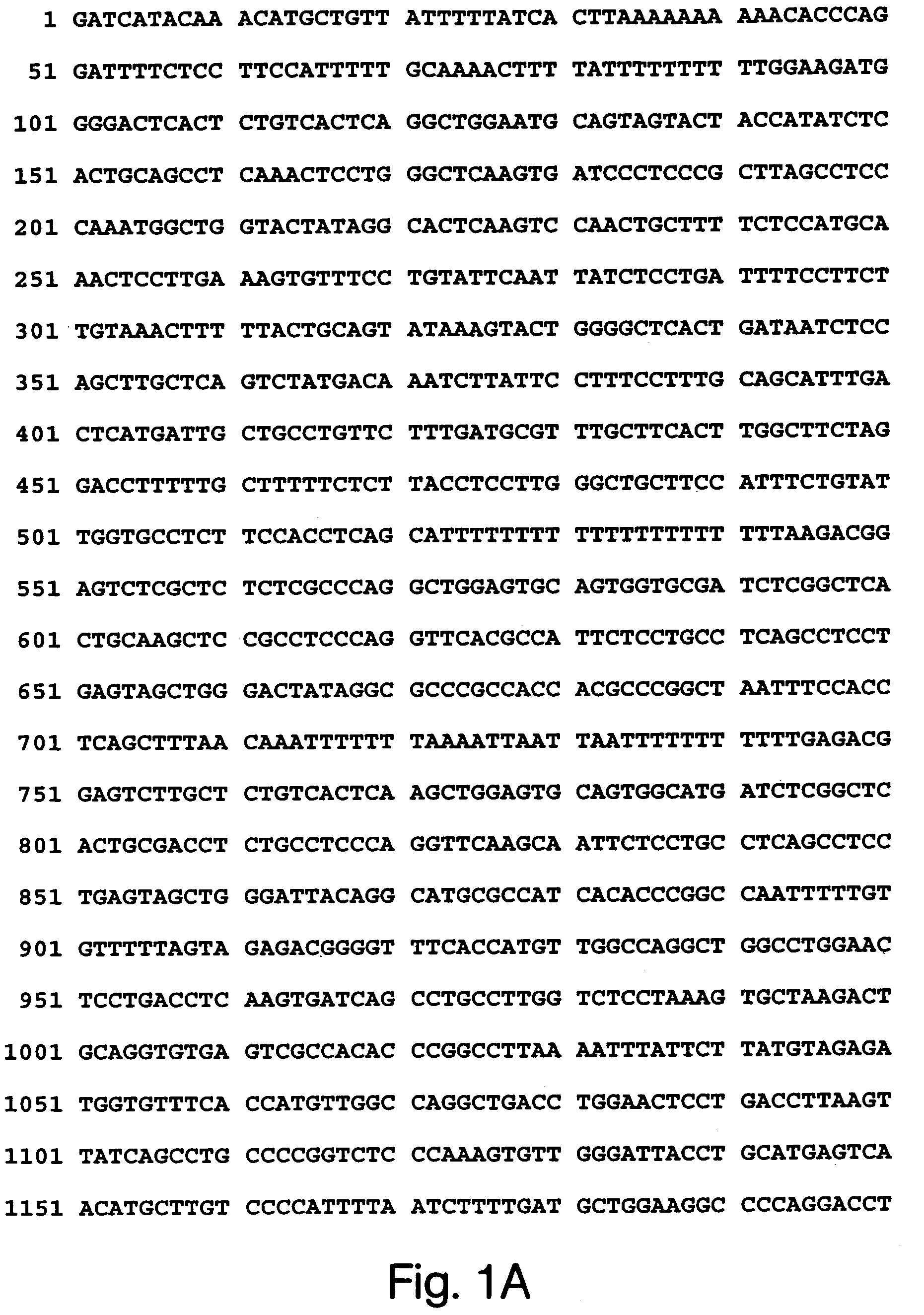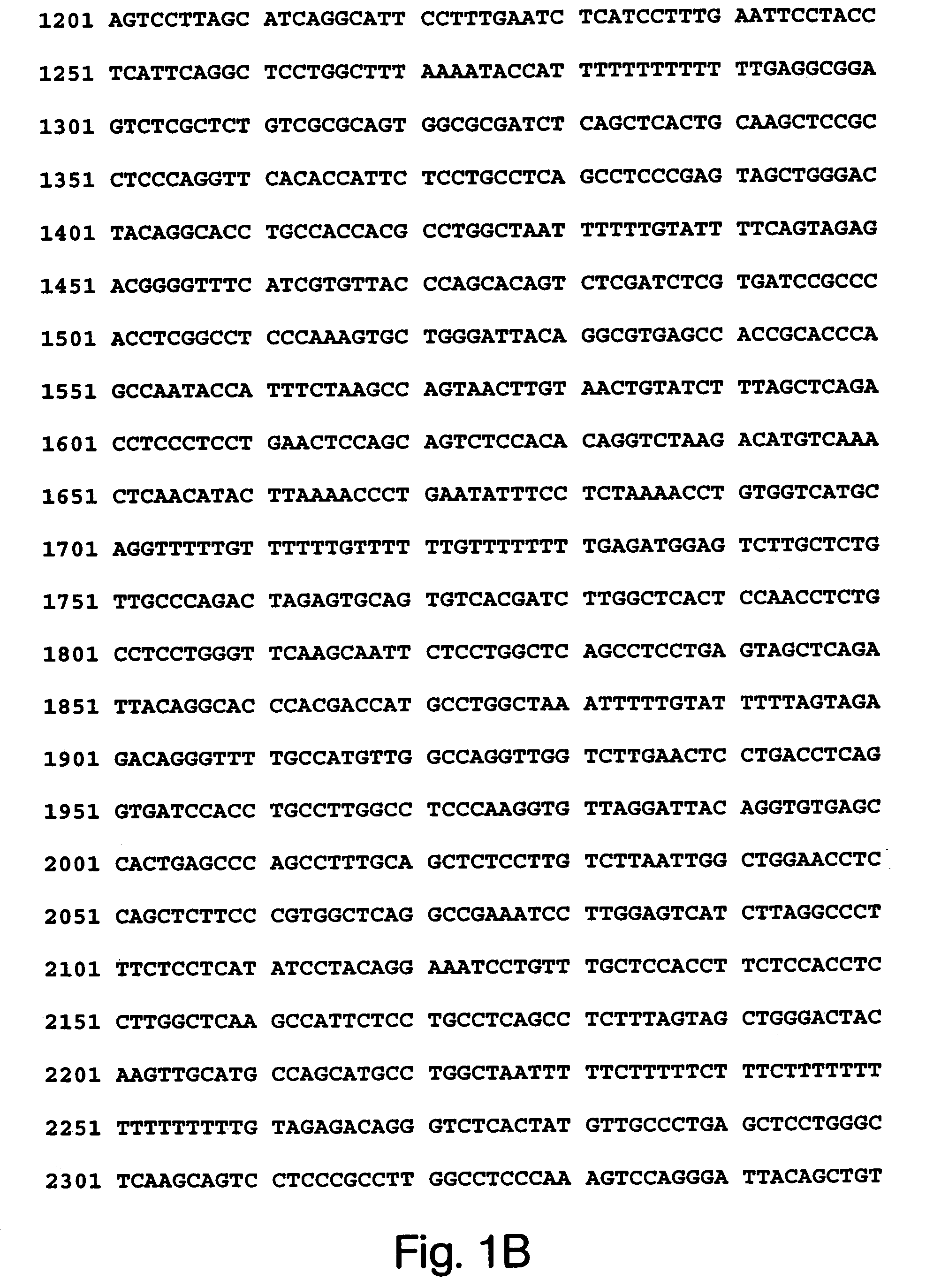Renal regulatory elements and methods of use thereof
a technology of renal regulatory elements and nucleic acids, applied in the field of nucleic acids, can solve the problems of inability or even death, damage to kidney tissue, impair kidney function, etc., and achieve the effect of treating or and preventing renal tissue injury
- Summary
- Abstract
- Description
- Claims
- Application Information
AI Technical Summary
Benefits of technology
Problems solved by technology
Method used
Image
Examples
example 1
Cloning and Characterization of KIM-1 Derived Sequences
[0100]Cis-acting KIM-1 derived regulatory sequences were identified by screening a human genomic library with a 220 bp Not1-Kpn1 DNA fragment containing sequences in the 5′ region of the human KIM-1 cDNA. The human KIM-1 cDNA is described generally in PCT publication WO97 / 44460 and Ichimura et al., J. Biol. Chem. 273:4135–42, 1998.
[0101]The screening identified a genomic fragment of 8933 bp (SEQ ID NO:1). The sequence of the 8933 bp region is shown in FIGS. 1A–1H. A translational start codon is present beginning at nucleotide 8655.
[0102]A 4817 bp KpnI-KpnI fragment (SEQ ID NO:2), which corresponds to nucleotides 3796–8612 of FIGS. 1A–1H, was subcloned into a luciferase-encoding pGL3b expression vector (Promega Corp.) and named p4.8KIM / pGL3b. The p4.8KIM / pGL3K construct is shown schematically in FIG. 2B. The presence of the 4817 bp KpnI-KpnI fragment in the pLUC3 was found to increase levels of encoded luciferase in renal cells, ...
example 2
Expression in Kidney Cells of Reporter Sequences Operably Linked to KIM-1 Derived Sequences
[0105]Human genomic sequences from the 5′ region of the human KIM-1 gene were tested for their ability to direct expression of a reporter polypeptide in three kidney-derived cell lines COS cells, a cell line derived from African green monkey kidney fibroblasts; LC / PK cells, a cell line derived porcine kidney epithelial cell lines; and MDCK cells, a cell line derived from canine kidney epithelial cells.
[0106]The cell lines were transiently transfected with constructs containing various regions of DNA from the human KIM-1 gene linked to a reporter luciferase gene. These constructs were concomitantly transfected with pCMV driven β-galactosidase vectors to standardize transfection efficiency, and activity of luciferase and β-galactosidase was measured. Activities were calculated as luciferase / β-gal ratios. Relative activities were calculated as the ratio of construct activity to negative control, ...
example 3
Expression in Kidney Cells of Reporter Sequences Operably Linked to KIM-1 Derived Sequences Following Injury
[0124]Expression of luciferase encoded by 4.8 pKIM, 1.3 pKIM, and 0.5 pKIM was measured in transfected HK2 cells that had been subjected to chemical anoxia using cyanide and deoxyglucose. HK2 cells are derived from epithelial proximal tubule cells from human kidney.
[0125]A 12-well plate system (MULTIWELL™ 12-well, Becton-Dickson) was used in these studies. The culture medium used was EGM (Clontech). Prior to transformation, 2 ml medium per well was added to the cells, then removed by aspiration. HK2 cells were seeded at a density of 30,000 / well. Cells reached 80% confluence after 16–24 hours.
[0126]DNA was prepared by mixing 50 μl of serum free medium, 5 μg of DNA (2.5 μg luciferase construct, 0.5 μg β-galactosidase vector, 2 μg BlueScript vector), and 5 μl of SUPERFECT reagent (Qiagen Corp.), and incubating for 7 minutes. 300 μl of medium+10% FCS was added, and the mix was the...
PUM
| Property | Measurement | Unit |
|---|---|---|
| Temperature | aaaaa | aaaaa |
| Fraction | aaaaa | aaaaa |
| Time | aaaaa | aaaaa |
Abstract
Description
Claims
Application Information
 Login to View More
Login to View More - R&D
- Intellectual Property
- Life Sciences
- Materials
- Tech Scout
- Unparalleled Data Quality
- Higher Quality Content
- 60% Fewer Hallucinations
Browse by: Latest US Patents, China's latest patents, Technical Efficacy Thesaurus, Application Domain, Technology Topic, Popular Technical Reports.
© 2025 PatSnap. All rights reserved.Legal|Privacy policy|Modern Slavery Act Transparency Statement|Sitemap|About US| Contact US: help@patsnap.com



